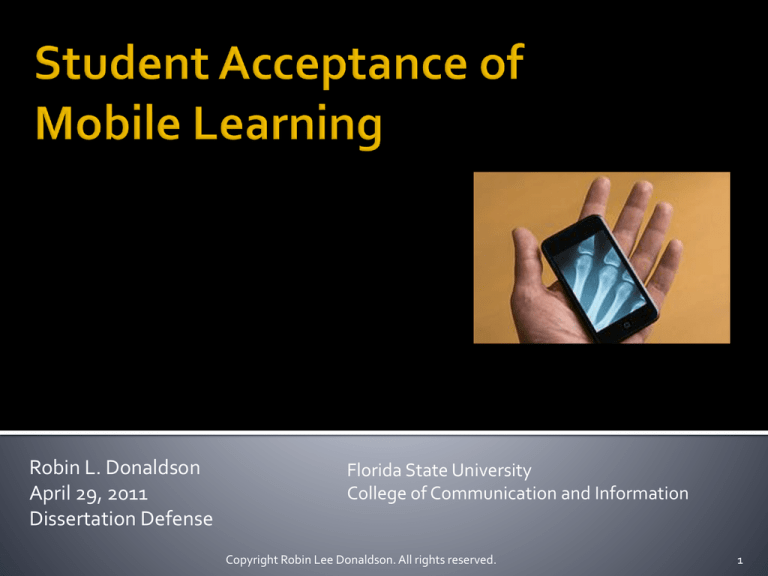
Robin L. Donaldson
April 29, 2011
Dissertation Defense
Florida State University
College of Communication and Information
Copyright Robin Lee Donaldson. All rights reserved.
1
Study of technology acceptance using IS
theories has received extensive attention from
research in information systems, library
information studies, and from education
researchers, however:
Limited research using IS models
Mobile learning may have unique characteristic
IS models may not fully address mobile learning
Impact of mobile devices on higher education and use
for access to library and information resources is
unclear
Copyright Robin Lee Donaldson. All rights reserved.
2
Use technology acceptance theory as a
theoretical framework to examine the
determinants associated with community
college students’ acceptance and use of
mobile learning.
Copyright Robin Lee Donaldson. All rights reserved.
3
Performance Expectancy
▪ “the degree to which an individual believes that using the
system will help him or her to attain gains in job
performance”
Effort Expectancy
▪ “the degree of ease associated with the use of the system”
Social Influence
▪ “the degree to which an individual perceives that important
others believe he or she should use the new system”
Facilitating Conditions
▪ “the degree to which an individual believes that an
organizational and technical infrastructure exists to support
use of the system”
Copyright Robin Lee Donaldson. All rights reserved.
4
Self-management of learning is “the extent
to which an individual feels he or she is selfdisciplined and can engage in autonomous
learning”
Copyright Robin Lee Donaldson. All rights reserved.
5
Perceived playfulness -a state of mind that
includes three dimensions: the extent to
which the individual:
perceives that his or her attention is focused,
curious during and
finds the interaction intrinsically enjoyable or
interesting.
Copyright Robin Lee Donaldson. All rights reserved.
6
Voluntariness of Use
“the degree to which use of the innovation is
perceived as being voluntary, or of free will”
Copyright Robin Lee Donaldson. All rights reserved.
7
Mixed Method
Procedure
Archival survey analysis
Interviews
Copyright Robin Lee Donaldson. All rights reserved.
8
Archival survey data
UTAUT -Venkatesh, Morris, Davis, and Davis (2003)
Wang, Wu, and Wang (2008)
Demographic and opinion-related questions
gender/age
access to a home computer
Internet experience;
frequency of use of mobile devices;
types of information, and library and learning resources
currently used and interested in accessing
Copyright Robin Lee Donaldson. All rights reserved.
9
Likert scales (1–7)
Anchors
1 Strongly agree
2 Agree
3 Moderately agree
4 Slightly agree
5 Neutral
6 Disagree
7 Strongly disagree
Copyright Robin Lee Donaldson. All rights reserved.
10
Community College in North Florida
Convenience Sample
Students enrolled in credit courses
330 participants
Average Age: 27
Gender: Females: 61.8% Males: 38.2%
Copyright Robin Lee Donaldson. All rights reserved.
11
a-priori power analysis
No. of participants required to detect a
medium effect size (d = .50) with power = .80
for a two-tailed independent samples t-test
at a = .05.
Suggested that 128 needed to achieve a power of
.80 given these parameters
Statistical software G*Power 3.0.8
Copyright Robin Lee Donaldson. All rights reserved.
12
Is there a statistically significant difference
between males and females on the behavioral
intention to use mobile learning?
H0: There will be no statistically significant difference
between the males and females on the behavioral
intention to use mobile learning.
Analysis: independent samples t-test
Copyright Robin Lee Donaldson. All rights reserved.
13
t (289) = -2.03, p < .05
Copyright Robin Lee Donaldson. All rights reserved.
14
Are there statistically significant relationships
among the participants’ age, behavioral
intention to use mobile learning and the actual
use of mobile learning?
H0: There will not be a statistically significant
relationship between the participants’ age and their
behavioral intention to use mobile learning.
Analysis: Simple linear regression
Copyright Robin Lee Donaldson. All rights reserved.
15
F (1, 266) = 0.03, = 0.01, p > .05, R2 = .00
Copyright Robin Lee Donaldson. All rights reserved.
16
Copyright Robin Lee Donaldson. All rights reserved.
17
Are the following independent variables
significant predictors of the behavioral intention
to use mobile learning:
1.
2.
3.
4.
performance expectancy 5. perceived playfulness
effort expectancy
6. self-management of
social influence
learning
facilitating conditions
7. voluntariness of use
Analysis: multiple regression
Copyright Robin Lee Donaldson. All rights reserved.
18
Copyright Robin Lee Donaldson. All rights reserved.
19
Demographic and opinion-related questions
•Personal activities
•Frequency of Internet access
•Internet experience
•Types of information, and library and learning
resources currently used and interested in accessing
Copyright Robin Lee Donaldson. All rights reserved.
20
90.0%
84.4%
78.3%
80.0%
76.8%
70.0%
61.1%
60.0%
54.1%
50.6%
50.0%
47.1%
40.4%
40.0%
26.8%
30.0%
29.9%
20.0%
8.6%
10.0%
0.0%
n=314
Copyright Robin Lee Donaldson. All rights reserved.
21
60
50
47.9%
40
30
22.3%
20
13.9%
8.4%
10
3.6%
3.9%
1 – 2 days a week
1 – 3 times a month
0
Several times a day
1 – 2 times a day
3 – 5 days a week
Copyright Robin Lee Donaldson. All rights reserved.
Never
22
Podcasts
16.5%
Library resources
19.4%
eBooks and journals
19.8%
Video
50.7%
Social networks
58.6%
Internet
81.7%
0
10
20
30
40
50
60
70
80
90
Other information apps
33.8%
Shopping
35.6%
News
59%
Maps and directions
64.7%
Weather
Copyright Robin Lee Donaldson. All rights reserved.0
71.9%
10
20
30
40
50
60
70
2380
Library blog
24.8%
Videos & Audio
41%
Ask-a-librarian
47.1%
Book & movie reserves
50.4%
Catalog databases
54%
eBooks
62.2%
Text a librarian
65.5%
0
Copyright
Robin20Lee Donaldson.
10
30All rights reserved.
40
50
60
70
24
Reading improvement videos
35.7%
Writing/grammar videos
41.6%
Math videos
52.1%
URL's
52.4%
PPT
53.5%
Audio
54.5%
Video
57.3%
Flash cards
61.5%
eTextbooks
72.7%
Blackboard
89.6%
0
Copyright
Robin
All
10
20 Lee Donaldson.
30
40 rights reserved.
50
60
70
80
90
100
25
Gather additional data not revealed in survey
Increase understanding of determinants,
barriers, and perceptions on use
Determinates of acceptance expected but not
pre-designed in interview
Copyright Robin Lee Donaldson. All rights reserved.
26
Research Question 4 What factors influence community college
student’s use of mobile devices for learning?
Copyright Robin Lee Donaldson. All rights reserved.
27
Research Setting – same
Sample Population - same
Participants - 20
Convenience sampling
Selecting participants
Courses targeted – diverse disciplines, level, and utilize
library or online resources
Copyright Robin Lee Donaldson. All rights reserved.
28
Semi structured
Research question guide discussion
Protocol
One interviewer
Script
Face-to-face, online, or phone
Coded using inductive analysis
Themes (16) derived from interview data
Copyright Robin Lee Donaldson. All rights reserved.
29
Ownership, acceptance, device attributes, cost,
and mobile access to academic services
Knowledge of Library Resources
▪ No knowledge of availability & benefits (35%)
▪ “I don’t really know if I can access all that information”
Copyright Robin Lee Donaldson. All rights reserved.
30
90% felt mobile learning useful for
supporting learning
Manage time
Productive
Organize thoughts & tasks
Prepare for class
85% use calendar function
40% - Anywhere/anytime access (mobility)
Copyright Robin Lee Donaldson. All rights reserved.
31
70% Facebook & 60% texting classmates
“…Makes it easier to kind of actually form a
community in a sense. Form a community—and you
actually get to know people and study together and
things like that.”
Faculty
respond “quicker than email..usually within the hour”
Too personal, not professional, keep school separate,
not give faculty personal phone number (30%)
Copyright Robin Lee Donaldson. All rights reserved.
32
Overall, not perceived as supporting or
recommending use in or outside of the classroom
▪ “..older instructors aren’t real comfortable accepting new
tecnology…”
▪ “…never actually spoke to a professor about it because normally
they just don’t want to see your phone.”
▪ Turn off in class/out of hands – no note taking
Instances of support were provided by some
May readily accept learning if faculty or their peers do so
and feel it is beneficial
Copyright Robin Lee Donaldson. All rights reserved.
33
No direct question
35% Identified playfulness component
“…more likely to do it because it wouldn’t seem
much of a chore…
“fun”
Lose track of time or explore further
Copyright Robin Lee Donaldson. All rights reserved.
34
Suggests no significant difference between
males and females and intended use of
mobile learning.
Findings were unexpected
Prior research - moderating effect of gender on
predictor variables
This research – examined differences between
males and females on BI
Need additional research
Copyright Robin Lee Donaldson. All rights reserved.
35
Suggests age does not have a relationship with intention to use
mobile learning
Findings were unexpected
Prior - Wang, Wu, Wang (2008) research - moderating effect of gender on
predictor variables. Computer literature suggest a there is an age relationship
This research – examined differences between males and females on BI
May be due to the age range of the participants 27.13 years
average
Nine out of ten 18-29 year old more likely to use mobile data
applications
65% access the Internet from their cell phones (Smith, 2010)
Need additional research
Copyright Robin Lee Donaldson. All rights reserved.
36
Omnibus model accounts for 75 %
percent of the variance in BI to use
•UTAUT study (70%)
•Wang et al., (2008) (58%)
Regression coefficients for all respondents
*p < 0.05 **p < 0.01
Copyright Robin Lee Donaldson. All rights reserved.
37
Clear interest in mobile access to learning and library
information content
Experience with browsing/searching on mobile
devices
higher levels of BI to use, perceived ease of use, and
perceived usefulness of mobile learning (Akour, 2009)
Potential to reduce digital divide (Hahn,2008)
Increased usage for personal purposes may lead to
increased demand for mobile academic purposes
Copyright Robin Lee Donaldson. All rights reserved.
38
Students are interested in mobile access to
library resources and services
Point toward the need to familiarize students
with:
benefits of mobile access to library resources
mobile library resources available
completing various learning tasks,
recommendations for applications
Copyright Robin Lee Donaldson. All rights reserved.
39
Point toward the need to:
provide support for mobile access to services
assist students in gaining necessary skills and
knowledge to successfully use mobile learning
promote the performance benefits of usage
Copyright Robin Lee Donaldson. All rights reserved.
40
Point toward the need to familiarize students
with:
ways to support both classroom and remote
learning
available instructional mobile resources
performance benefits and ‘playfulness’ aspect
and providing content and information on
resources formatted for mobile devices
Copyright Robin Lee Donaldson. All rights reserved.
41
Convenience sample
Cross sectional
Single community college -not generalizabile
Statistical significance within the design does not imply causeand-effect relationships
Predictors identified may not be found to be predictors in other
mobile learning research. Those that were not found to be
predictors may be found to be predictors in other mobile
learning research
Copyright Robin Lee Donaldson. All rights reserved.
42
Examine self-management alone to understand its
importance as a predictor in mobile learning.
Examine the significance of the predictors for educators.
Examine effort expectancy using individuals with varying
levels of experience with mobile devices and a wider age
range of users.
Similar research on mobility as a significant predictor for
access to digital resources and support from academic
libraries
Copyright Robin Lee Donaldson. All rights reserved.
43
Copyright Robin Lee Donaldson. All rights reserved.
44
Schaefer, Andreas (2008). iX-ray. Retrieved from:
http://flickrcc.bluemountains.net
Also available in multiple sizes at Flickr Website:
http://www.flickr.com/photos/36266791@N00/2986303105
Some rights reserved. This image is licensed with a Creative
Commons Attribution, Non-Commercial, Share Alike license.
http://creativecommons.org/licenses/by-nc-sa/2.0/deed.en
Copyright Robin Lee Donaldson. All rights reserved.
45
H1. Performance expectancy will not have a positive effect on behavioral intention
to use mobile learning.
H2. Effort expectancy will not have a positive effect on behavioral intention to use
mobile learning.
H3. Social influence will not have a positive effect on behavioral intention to use
mobile learning.
H4. Self-management of learning will not have a positive effect on behavioral
intention to use mobile learning.
H5. Perceived playfulness will not have a positive effect on behavioral intention to
use mobile learning.
H6. Voluntariness of use will not have a positive effect on behavioral intention to use
mobile learning.
H7. Behavioral intention will not have a positive influence on mobile learning
intention to use .
H8. Facilitating conditions will not have a positive influence on mobile learning
intention to use.
Copyright Robin Lee Donaldson. All rights reserved.
46








